Falabella Bundle
Who Really Owns Falabella?
In the ever-shifting world of retail giants, understanding the ownership of Falabella is key to unlocking its future. Knowing who controls this powerhouse, with its fingers in department stores, home improvement, and financial services, reveals its strategic ambitions and market influence. Uncover the intricate web of Falabella SWOT Analysis to gain a deeper understanding of its strengths, weaknesses, opportunities, and threats.
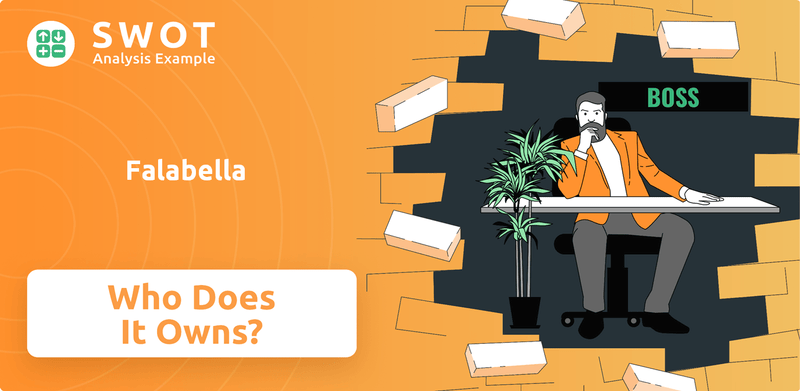
From its humble beginnings as a tailor shop to its current status as a multinational corporation, the Falabella company's ownership structure has evolved significantly. This exploration of Falabella ownership will reveal the key players, from the founding family to institutional investors, who shape the company's direction. Understanding who owns Falabella is crucial for anyone seeking to understand the company's long-term strategy and its impact on the Latin American retail landscape. The Falabella company history is rich with stories of adaptation and expansion.
Who Founded Falabella?
The origins of the Falabella company trace back to 1889. Salvatore Falabella, an Italian immigrant, established a tailor shop in Santiago, Chile. This marked the beginning of what would become a significant retail enterprise.
In 1937, Alberto Solari joined the company, playing a crucial role in its expansion. His involvement transformed the business into a prominent clothing store. This move diversified product offerings and expanded the number of sales points.
The introduction of household products in 1958 was another pivotal moment. This led to the creation of Chile's first department store. This strategic shift highlighted an early vision for growth and diversification.
Specific equity splits or initial shareholding percentages for Salvatore Falabella and Alberto Solari at the company's inception are not publicly detailed.
The Solari family's continued presence in the company's leadership and ownership over generations indicates a strong foundational vision and enduring influence.
The transformation from a tailor shop to a department store reflects an early strategic vision focused on expanding product categories and market reach.
The founding team's entrepreneurial spirit drove the company's evolution and expansion.
Early agreements, such as vesting schedules or buy-sell clauses, are not explicitly documented in publicly available historical accounts.
The company's growth was fueled by a focus on expanding product categories and market reach.
Understanding the Falabella ownership structure requires examining its early history. While specific details of the initial shareholding are not readily available, the influence of the Solari family has been significant. The company's evolution from a tailor shop to a department store demonstrates a clear strategic vision. As of 2024, the company continues to be a major player in the retail sector. Key figures like the Falabella CEO and other Falabella company leadership have played crucial roles in steering the company. For detailed Falabella company financial reports and Falabella company stock information, one should consult the latest filings. The company's history shows a commitment to adaptation and growth. The Falabella shareholders have benefited from this long-term vision. The current Who owns Falabella structure reflects this legacy.
Key aspects of Falabella history and ownership include:
- Salvatore Falabella founded the company in 1889.
- Alberto Solari joined in 1937, expanding the business.
- The Solari family has maintained a strong influence.
- The company's early focus was on expanding product lines.
- The company is a major player in the retail sector as of 2024.
Falabella SWOT Analysis
- Complete SWOT Breakdown
- Fully Customizable
- Editable in Excel & Word
- Professional Formatting
- Investor-Ready Format
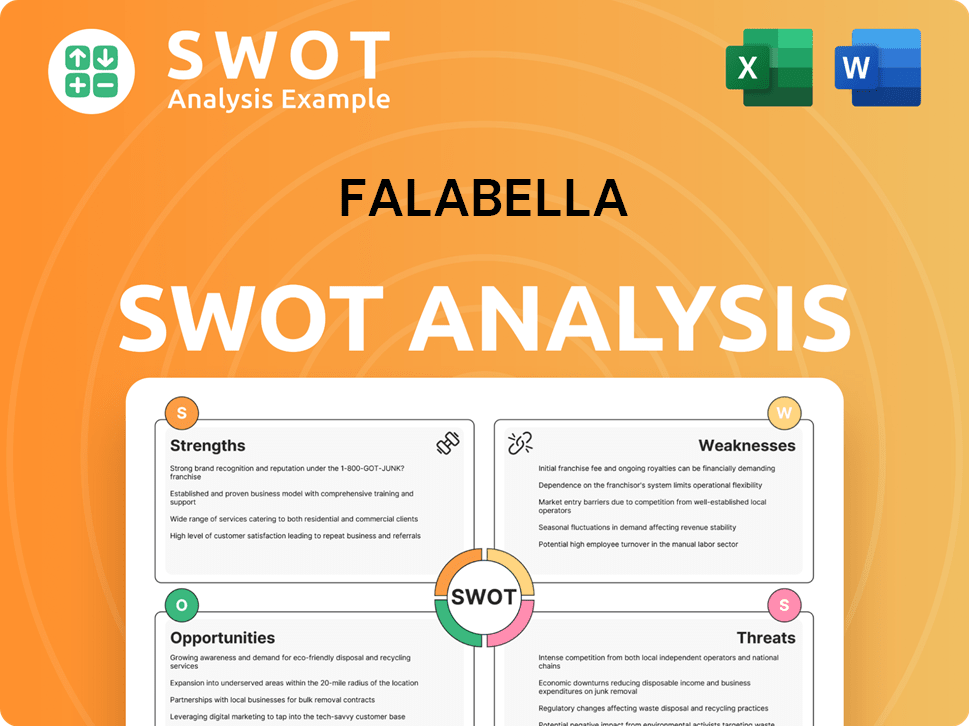
How Has Falabella’s Ownership Changed Over Time?
The evolution of Falabella ownership has been marked by significant shifts since it became a publicly traded company in 1996. Initially, the ownership was concentrated among founding families, but over time, institutional investors and public shareholders have gained notable stakes. As of June 13, 2025, the market capitalization of the Falabella company is approximately CL$12.25 trillion, reflecting its substantial presence in the retail sector.
The Falabella company ownership structure is a blend of family-related investment vehicles and institutional investors. Key family-related entities, such as Inversiones Auguri, Ltda., and Inversiones y Rentas Don Alberto Cuatro, S.A., hold significant percentages of shares. These entities are often linked to the descendants of the founding families, particularly the Solari family. Institutional investors, including BlackRock, Inc., also play a crucial role. These diverse shareholders influence the company's strategic direction and governance.
| Stakeholder | Percentage of Ownership (as of Dec 30, 2024) | Notes |
|---|---|---|
| Inversiones Auguri, Ltda. | 10.67% | Family-related investment vehicle |
| Inversiones y Rentas Don Alberto Cuatro, S.A. | 10.34% | Family-related investment vehicle |
| Inversiones San Vitto Limitada | 9.71% | Family-related investment vehicle |
Major events have influenced who owns Falabella. In April 2024, Mallplaza, a subsidiary, acquired Falabella Perú S.A.A., consolidating real estate operations in Peru. This strategic move, valued at US$589 million, demonstrates the company's efforts to streamline its structure. These changes impact the overall strategic direction and governance of the Falabella Group. For insights into the competitive landscape, consider exploring the Competitors Landscape of Falabella.
The ownership of Falabella is a mix of family interests and institutional investors, influencing the company's strategic direction. Key family-related entities hold substantial shares, reflecting the legacy of the founding families. Institutional investors also have a significant presence, indicating broader market interest.
- Family-related investment vehicles hold significant stakes.
- Institutional investors, like BlackRock, Inc., are major shareholders.
- Strategic acquisitions, such as the consolidation of Peruvian operations, impact ownership.
- The Solari family and Jose Luis del Río Goudie are key figures.
Falabella PESTLE Analysis
- Covers All 6 PESTLE Categories
- No Research Needed – Save Hours of Work
- Built by Experts, Trusted by Consultants
- Instant Download, Ready to Use
- 100% Editable, Fully Customizable
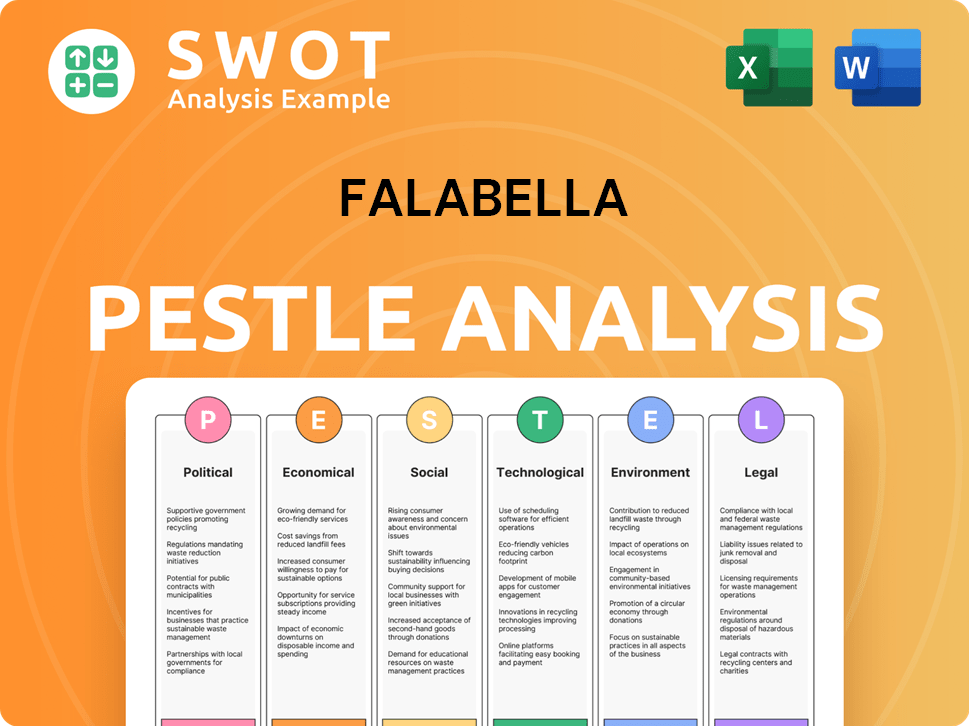
Who Sits on Falabella’s Board?
The governance of the Falabella company is overseen by a Board of Directors comprised of nine members. These directors serve three-year terms and are eligible for re-election. This board is crucial in guiding the company's strategic direction and ensuring effective corporate governance. As of June 2025, the Chairman of the Board is Enrique Ostalé Cambiaso, who took on the role in 2023. Juan Carlos Cortés Solari serves as the Vice-Chairman.
The board includes representatives from major shareholder groups, often linked to the founding families. Key figures include María Cecilia Karlezi Solari and Carlo Solari Donaggio. Independent directors, such as Andres Orsini and German Pasquale Vilardo, are also part of the board, adhering to Chilean corporate law requirements. Jose del Rio Goudie and Paola Cuneo Queirolo also serve as directors. The board's composition reflects a balance between shareholder representation and independent oversight, crucial for managing the interests of Falabella shareholders.
| Board Member | Position | Affiliation |
|---|---|---|
| Enrique Ostalé Cambiaso | Chairman | |
| Juan Carlos Cortés Solari | Vice-Chairman | |
| María Cecilia Karlezi Solari | Director | Grupo Auguri |
| Carlo Solari Donaggio | Director | |
| Jose del Rio Goudie | Director | |
| Paola Cuneo Queirolo | Director | |
| Andres Orsini | Independent Director | |
| German Pasquale Vilardo | Independent Director |
The voting structure at Falabella company generally follows a one-share-one-vote principle. Board decisions are approved by a majority vote of the attending members with voting rights, with the Chairman holding a tie-breaking vote. There are no indications of special voting rights that would grant outsized control to specific individuals beyond their proportional shareholding. The Annual Shareholders' Meeting in April 2024 addressed key matters, including the designation of risk rating agencies and board member compensation, demonstrating a commitment to shareholder value and sound financial practices for Who owns Falabella.
The Board of Directors plays a vital role in overseeing the Falabella ownership structure.
- Board members represent major shareholder interests.
- Independent directors ensure oversight and compliance.
- Voting follows a one-share-one-vote principle.
- The company focuses on strategic efficiency and financial strengthening.
Falabella Business Model Canvas
- Complete 9-Block Business Model Canvas
- Effortlessly Communicate Your Business Strategy
- Investor-Ready BMC Format
- 100% Editable and Customizable
- Clear and Structured Layout
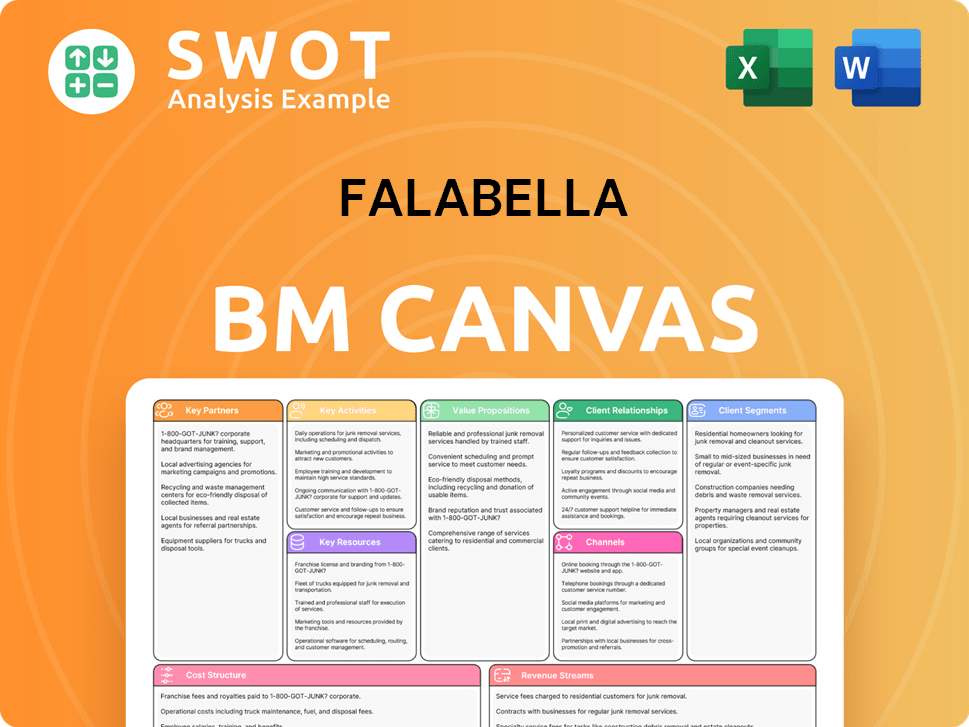
What Recent Changes Have Shaped Falabella’s Ownership Landscape?
Over the past few years, the ownership structure of the Falabella company has seen notable shifts. A significant leadership change occurred with the departure of CEO Gaston Bottazzini on January 1, 2024, and the appointment of Alejandro González Dale. In April 2024, Mallplaza, a subsidiary, acquired Falabella Perú S.A.A. for approximately US$454.2 million, consolidating real estate operations in Peru. Furthermore, in July 2024, the company repurchased US$100 million of capital on a bond maturing in 2027 as part of its financial strategy.
The financial performance of Falabella has improved, with net income reaching US$122 million in 2Q24, a 135% increase compared to 2Q23. Full-year 2024 earnings were US$483 million, eight times higher than in 2023. Consolidated revenues for Q4 2024 reached US$3.555 billion, up 13.5% year over year, with full-year revenues at US$12.197 billion, an 8.1% increase from 2023. These figures highlight strategic efforts in enhancing profitability and managing risk within its credit portfolio. Looking ahead to 2025, a US$650 million investment plan has been announced, focusing on store transformations, new openings, and technological advancements.
| Metric | 2Q24 | Full Year 2024 |
|---|---|---|
| Net Income (US$ million) | 122 | 483 |
| Revenue (US$ billion) | - | 12.197 |
| Investment Plan 2025 (US$ million) | - | 650 |
Industry trends indicate increased institutional ownership in the Falabella company, with major funds focusing on emerging markets holding significant stakes. The company's strategic focus on consolidating its position in key Latin American markets and improving financial metrics indicates a proactive approach to market trends and shareholder value. This ongoing investment and public trading lead to a broader distribution of ownership over time, affecting the Falabella ownership structure.
Falabella shareholders include institutional investors and the founding families. The company is publicly traded, resulting in a dispersed ownership structure. Major funds focusing on emerging markets hold significant stakes.
The current Falabella CEO is Alejandro González Dale, who took over on January 1, 2024. He replaced Gaston Bottazzini. Dale previously served as the Chief Financial and Administrative Officer.
The company is concentrating on consolidating its position in key Latin American markets. This includes strategic investments in store transformations and expansion, as well as strengthening its technological capabilities.
Falabella has shown improved financial results, with increased net income and revenue. The company is also focused on improving profitability and managing risk within its credit portfolio.
Falabella Porter's Five Forces Analysis
- Covers All 5 Competitive Forces in Detail
- Structured for Consultants, Students, and Founders
- 100% Editable in Microsoft Word & Excel
- Instant Digital Download – Use Immediately
- Compatible with Mac & PC – Fully Unlocked
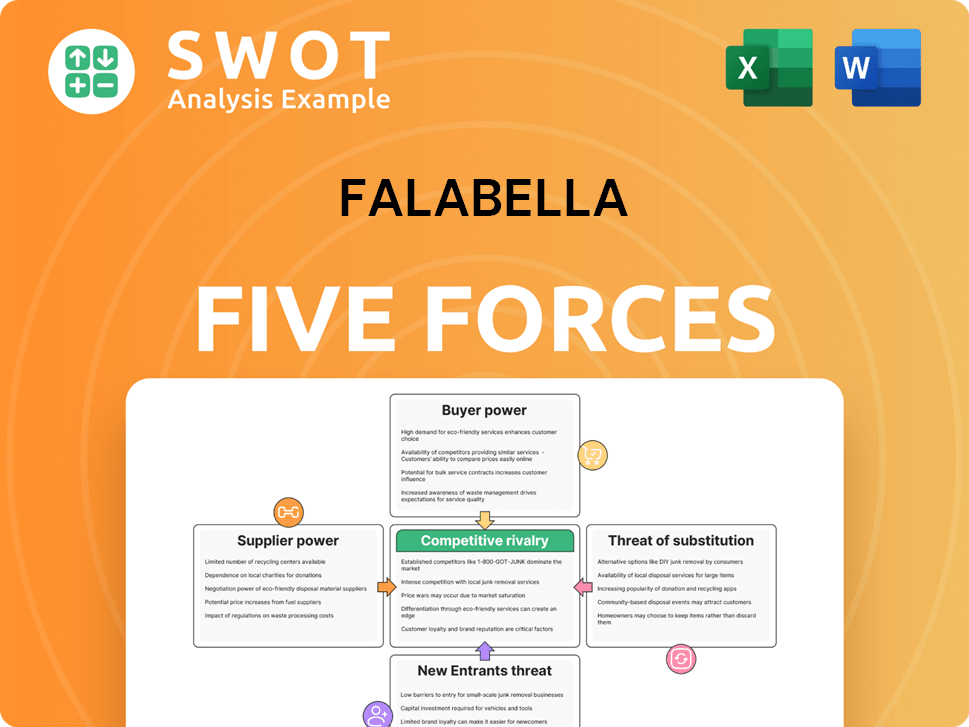
Related Blogs
- What are Mission Vision & Core Values of Falabella Company?
- What is Competitive Landscape of Falabella Company?
- What is Growth Strategy and Future Prospects of Falabella Company?
- How Does Falabella Company Work?
- What is Sales and Marketing Strategy of Falabella Company?
- What is Brief History of Falabella Company?
- What is Customer Demographics and Target Market of Falabella Company?
Disclaimer
All information, articles, and product details provided on this website are for general informational and educational purposes only. We do not claim any ownership over, nor do we intend to infringe upon, any trademarks, copyrights, logos, brand names, or other intellectual property mentioned or depicted on this site. Such intellectual property remains the property of its respective owners, and any references here are made solely for identification or informational purposes, without implying any affiliation, endorsement, or partnership.
We make no representations or warranties, express or implied, regarding the accuracy, completeness, or suitability of any content or products presented. Nothing on this website should be construed as legal, tax, investment, financial, medical, or other professional advice. In addition, no part of this site—including articles or product references—constitutes a solicitation, recommendation, endorsement, advertisement, or offer to buy or sell any securities, franchises, or other financial instruments, particularly in jurisdictions where such activity would be unlawful.
All content is of a general nature and may not address the specific circumstances of any individual or entity. It is not a substitute for professional advice or services. Any actions you take based on the information provided here are strictly at your own risk. You accept full responsibility for any decisions or outcomes arising from your use of this website and agree to release us from any liability in connection with your use of, or reliance upon, the content or products found herein.